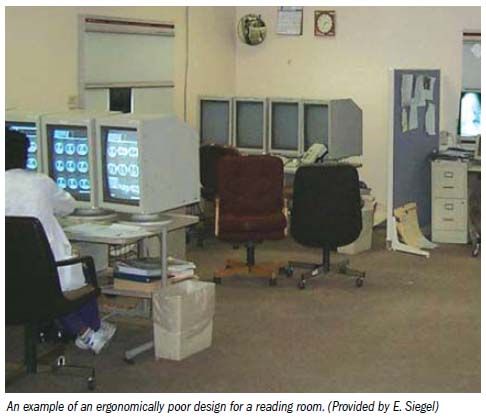Poor ergonomic design plagues reading rooms
A recent study from Massachusetts General Hospital finding that radiologists suffer from poor ergonomics in the reading room put a spotlight on a relatively common problem in radiology.
A recent study from Massachusetts General Hospital finding that radiologists suffer from poor ergonomics in the reading room put a spotlight on a relatively common problem in radiology. Although the study was confined to MGH, at least one expert says that poorly designed digital reading rooms are common in the U.S.
In their ongoing study, researchers at MGH sent a written questionnaire to 28 randomly selected radiologists from various divisions. Only 7.2% were symptom free. Of the rest, some radiologists experienced multiple symptoms. Neck pain was felt by 42.8%, low back pain by 39.2%, shoulder pain by 32.1%, headache by 32.1%, and wrist pain by 7.4%. The study was presented at the ARRS meeting.
While the study took place at MGH, poor ergonomics are the rule rather than the exception, said Dr. Eliot Siegel, vice chair of radiology at the University of Maryland (UMD) and chief of imaging for the VA Maryland healthcare system. Siegel travels around the country and lectures on ergonomics as someone with experience with the subject. He estimates at least half of all reading rooms are poorly designed.
UMD created an ergonomically correct Radiology Reading Room of the Future as a model to showcase what's available to radiologists. When UMD became the first filmless radiology department in the U.S. they wheeled out the view boxes and alternators and brought in computer monitors without realizing certain changes were necessary, Siegel said.
“People have overhead fluorescent lights that work in a film-based environment that really don't work in a digital environment,” Siegel said.
In a film-based environment radiologists frequently left their chairs to put films away or grab new ones. Now they're are sitting in one seat all day because the images are all available on a PACS.
“If you just take the old view boxes out, put in new digital workstations, and keep the same chairs and the same lighting, and have people sit for longer periods of time, it creates problems,” Siegel said.

The problems are much like what was found at MGH: neck problems, back problems, eye strain, shoulder strain, wrist injuries, carpal tunnel syndrome, and cubital tunnel
syndrome.
“It's funny, when I show people what I say is the poster child for the worst reading room, how many come up to challenge that and say I should come out and visit their place because they have that reading room beat by far,” Siegel said.
To change the ergonomics of a reading room, radiologists should consider changes in room lighting, such as dimmable controls to allow maximum flexibility for each individual radiologist, and temperature control.
Another consideration is a blue background to reflect light with a blue shade from the walls because it has been shown to favorably affect visual acuity and minimize stress. One of UMD's rooms has a blue light source illuminating the wall behind the radiologist's workstation, Siegel said.
A simple task radiologists can perform to cut down on eye strain right away is to use the 20/20/20 rule. Siegel recommends every 20 minutes looking 20 feet away for 20 seconds. It relieves eyes constantly straining to look at something 18 to 22 inches away, he said.
The Reading Room: Artificial Intelligence: What RSNA 2020 Offered, and What 2021 Could Bring
December 5th 2020Nina Kottler, M.D., chief medical officer of AI at Radiology Partners, discusses, during RSNA 2020, what new developments the annual meeting provided about these technologies, sessions to access, and what to expect in the coming year.
Strategies to Reduce Disparities in Interventional Radiology Care
March 19th 2025In order to help address the geographic, racial, and socioeconomic barriers that limit patient access to interventional radiology (IR) care, these authors recommend a variety of measures ranging from increased patient and physician awareness of IR to mobile IR clinics and improved understanding of social determinants of health.